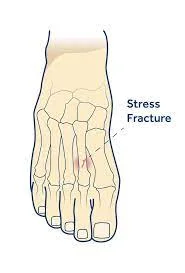Stress Fracture in The Foot
Table of Contents
Introduction
A stress fracture of the foot is a small crack in one of the metatarsal bones, which are the long bones that run from the ankle to the toes. Overuse is the most common cause, and it is rarely the result of falls or other accidents. You may not notice you have a stress fracture until days after the injury.
Stress fractures commonly occur after intense athletic training or competition. They are more common in the lower legs and feet’s weight-bearing bones.
Although the crack caused by a stress fracture is minor, it is critical to find medical care for this injury. Ignoring a stress fracture can aggravate it significantly. This, in turn, could result in a complete break of the affected bone.
Stress fracture pain typically develops gradually and worsens during weight-bearing activities. You may also notice point tenderness at the site of the fracture.
Stress fractures can occur when people change their activities, such as trying a new exercise or abruptly increasing the intensity of their workouts (jogging on a treadmill vs. jogging outside). Furthermore, if osteoporosis or another disease has weakened the bones, performing daily activities may result in a stress fracture.
It is critical to refrain from high-impact activities while recovering from a stress fracture in the foot or ankle. Returning to activity too soon can not only delay healing but also increase the risk of a complete fracture.
Causes
Overuse injuries are almost always the cause of stress fractures. This means they occur when something exerts excessive pressure on a bone and it does not have enough time to recover after physical activity. When you do a repetitive motion (such as training for a sport or performing the same type of movement all day at work), stress fractures usually develop slowly over time.
Stress fractures begin as inflammation on the surface of a bone. Stress reactions are comparable to deep bone bruises. If you continue to put pressure on the same spot before the stress reaction heals, your bone can crack and form a stress fracture. Over time, the bruise will penetrate deeper into the bone, weakening it to breaking. That is when a stress reaction transforms into a stress fracture.
Some of the most typical causes of stress fractures are as follows:
- Excessive practice or training without adequate rest.
- We are beginning a new sport or physical activity without the necessary training, guidance, or equipment.
- Rapidly increasing your activity level (increased workouts, training, or other physical activity).
Changing the surface on which you train or work (for example, transitioning from indoor track to road running or beginning a job that requires you to stand on a hard floor like concrete). - Working or training without the necessary equipment.
- Specializing in one sport too early (children who play the same sport year-round with no breaks between seasons are more likely to suffer from a stress fracture than children who participate in a variety of sports).
- Increasing the duration and intensity of an exercise programme abruptly.
- Lower leg and foot muscle weakness.
- Poor joint mobility and range of motion, increase the loading on the bones.
- People who have osteoporosis or other conditions that cause bone density loss.
- People who take prescription drugs that reduce bone density.
- Poorly constructed footwear with little or no shock absorption.
- Vitamin D and calcium deficiency cause bone weakness.
- Excessive and unusual stress is caused by weight-bearing activities such as running, jumping, or dancing.
- Training or landing from a great height on hard surfaces.
Symptoms of the stress fracture in the foot
Pain in your foot or ankle is the most common and generic symptom of a stress fracture. Other symptoms of the condition could include:
- Pain, swelling, and tenderness over the bone.
- The sensation of pain can be dull, sharp, or intermittent.
- You may feel pain while sleeping.
- High-impact activity, such as running, hopping, or jumping, aggravates the pain.
- Inability to support weight.
It may begin as a dull pain in the foot or ankle that worsens during physical activity and goes away when you rest. You will most likely have ignored this pain for some time until its intensity increased and it caused you significant discomfort.
Risk factor
Athletes who participate in sports that place a lot of strain on their lower bodies are more likely to suffer from stress fractures, which include:
- Running (long-distance running as well as track and field sports).
- Basketball.
- Tennis.
- Gymnastics (gymnasts are also more likely to develop stress fractures in their hands and wrists).
- Dance.
Stress fractures can be caused by a variety of medical conditions, including:
- Osteoporosis (also known as insufficiency fractures by providers).
- Bunions.
- Feet with a high arch.
- Flat feet.
- Deficiency of vitamin D.
- Obesity or being overweight.
- Eating problems.
Diagnosis
Consider seeing a doctor if you have persistent foot pain that lasts more than a week despite home treatment. If your pain is severe enough to prevent you from walking, or if you have burning pain, numbness, or tingling on the affected foot, you should consult a doctor. If you visit your primary care physician, they may refer you to a podiatrist.
Physical examination
Your medical history and general health will be discussed with your doctor. They will inquire about your job, your activities, your diet, and any medications you are currently taking. Your doctor must be aware of your stress fracture risk factors. If you’ve previously had a stress fracture, your doctor may order a full medical work-up, including laboratory tests to look for nutritional deficiencies like low calcium or Vitamin D.
Your doctor will examine your foot and ankle after discussing your symptoms and medical history. They will look for tender spots and apply gentle pressure directly to the injured bone during the examination. The patient’s report of pain in response to this pressure is frequently the key to diagnosing a stress fracture. Pain from a stress fracture is usually limited to the area directly over the injured bone and does not spread throughout the foot.
Imaging tests
To help confirm the diagnosis, your doctor may order imaging tests.
X-rays. X-rays show images of dense structures like bone. Because a stress fracture begins as a tiny crack, it is frequently difficult to detect on an initial X-ray. The fracture may not be visible for several weeks after it has begun to heal. A type of healing bone called a callus may form around the fracture site after a few weeks. This is frequently the point at which the fracture line in the bone becomes visible.
Other imaging studies. If your doctor suspects a stress fracture but cannot see it on an X-ray, he or she may recommend a bone scan or an MRI scan. Although a bone scan is less specific than an MRI in determining the exact location of the stress fracture, both studies are more sensitive than X-rays and can detect stress fractures sooner.
If your stress fracture occurred while performing light activity, your doctor may recommend a bone density scan (DEXA scan) to assess the overall strength of your bones. This test can aid in the diagnosis of osteoporosis, and the results can help your doctor determine whether you are a candidate for medications to strengthen your bones.
Treatment of the stress fracture in the foot
If you suspect you have a stress fracture in your foot or ankle, see your doctor as soon as possible. Ignoring the pain can have serious ramifications. The bone may completely break.
Follow the RICE protocol until your doctor’s appointment.RICE is a shorter form for rest, ice, compression, and elevation.
Rest. Avoid activities that require you to put weight on your foot. If you must bear weight for any reason, wear a very supportive shoe. A cork sandal with a thick sole is preferable to a thin slipper. Always pay attention to your body. If certain positions or activities aggravate your pain, this is your body’s way of telling you that you are putting strain on the injured area.
Ice. To relieve swelling, use ice after the injury. Apply cold packs for 20 minutes at a time several times per day.
Compression. Wrap the area lightly in a soft bandage to prevent further swelling.
Elevation. Rest with your foot raised higher than your heart as much as possible.
The goal of treatment is to reduce pain and allow the fracture to heal so that you can resume your normal activities. Following your doctor’s treatment plan will allow you to return to activities sooner and prevent further bone damage.
Treatment will differ depending on the location and severity of the stress fracture. The vast majority of stress fractures are nonsurgically treated.
Non-surgical treatment
Along with the RICE protocol and anti-inflammatory medication, your doctor may advise you to use crutches to keep weight off your foot until the pain subsides. Other non-surgical treatment options could include:
Activities were altered. A stress fracture heals in 6 to 8 weeks on average. Switch to activities that put less strain on your foot and leg during this time. Swimming and cycling are both enjoyable alternatives. However, you should not resume any type of physical activity involving your injured foot or ankle, even if it is low impact, without first consulting your doctor.
Protective footwear. Your doctor may advise you to wear protective footwear to reduce stress on your foot and leg. This could be a stiff-soled shoe, a sandal with a wooden sole, or a removable short-leg fracture brace shoe.
Casting. Certain types of stress fractures may necessitate additional support. Your doctor may apply a cast to your foot to keep your bones in place and relieve stress on your affected leg.
Surgical Treatment
Some stress fractures necessitate surgery to heal properly. In most cases, this entails inserting an internal fixation to support the bones. During the healing process, specialized pins, screws, and/or plates are commonly used to hold the small bones of the foot and ankle together. If a stress fracture completely breaks and displaces, surgery may be required.
This type of surgery may be performed by your surgeon by making a small incision near the fractured bone or by inserting pins/screws through the skin. After the bone has healed, the hardware is usually not required to be removed. However, your surgeon may occasionally recommend that the hardware be removed; this is usually a quick outpatient procedure.
Rehabilitation of the stress fracture in the foot
In most cases, a stress fracture takes 6 to 8 weeks to heal. More severe stress fractures may take longer. Chronic stress fractures or stress fractures in bone with less blood supply may require more time to heal.
Although being sidelined with an injury can be difficult, returning to activity too soon can put you at risk for a prolonged recovery or even a sudden worsening of the fracture, which may necessitate surgery.
After your pain has subsided, your doctor may take X-rays to confirm that the stress fracture has healed. A computed tomography (CT) scan can also help determine healing, particularly in bones where the fracture line was initially difficult to see.
Your doctor will allow a gradual return to activity once the stress fracture has healed and you are pain-free. During the early stages of rehabilitation, your doctor may advise you to alternate days of activity and rest. This allows your bone to grow and adapt to the new demands placed on it. You can gradually increase the frequency, duration, and intensity of your exercise as your fitness level improves.
Prevention
The following guidelines can help you live a healthy lifestyle and avoid stress fractures:
- Consume calcium-rich foods and get enough Vitamin D every day to help maintain bone density.
- Wear comfortable shoes. Instead of wearing old or stiff shoes, try on some that are comfortable, well-padded, and supportive. It is usually a good idea to wear shoes designed specifically for the sport you intend to participate in. When possible, avoid wearing high heels.
- You must not smoke. This can cause issues with healing. Because it is nicotine that causes the problem, other nicotine-containing gum and products will still prevent the bone from healing.
- Cross-train. This means you should switch between activities. During the week, for example, you could alternate jogging with swimming or cycling.
- Gradually ease back into previous or new sports activities. Increase the time, speed, and distance gradually. Many experts recommend increasing your exercise time by 10% per week.
Summary
A stress fracture is a small crack in one of the metatarsal bones, which runs from the ankle to the toes. Overuse is the most common cause, and it is rarely the result of falls or accidents. Stress fractures are more common after intense athletic training or competition, and are more common in the lower legs and feet’s weight-bearing bones. They can occur when people change their activities, such as trying a new exercise or abruptly increasing the intensity of their workouts.
Stress fracture pain typically develops gradually and worsens during weight-bearing activities. It may also notice point tenderness at the site of the fracture. Causes of stress fractures include excessive practice or training without adequate rest, rapid activity level changes, changing the surface on which you train or work, working or training without the necessary equipment, specializing in one sport too early, increasing the duration and intensity of an exercise program abruptly, lower leg and foot muscle weakness, poor joint mobility and range of motion, osteoporosis, prescription drugs that reduce bone density, poorly constructed footwear, vitamin D and calcium deficiency, weight-bearing activities, and training or landing from a great height on hard surfaces.
Persistent foot pain lasting more than a week despite home treatment is a serious issue that should be treated by a doctor. A physical examination is conducted to discuss the patient’s medical history, including any risk factors for stress fractures. Imaging tests, such as X-rays, bone scans, and MRI scans, may be recommended to confirm the diagnosis.
Treatment focuses on reducing pain and allowing the fracture to heal, allowing the patient to resume normal activities. Most stress fractures are nonsurgically treated, with the majority being non-surgical. Non-surgical treatment options include using crutches, altering activities, wearing protective footwear, or applying a cast.
Surgical treatment may involve inserting an internal fixation to support the bones. Rehabilitation typically takes 6-8 weeks, with more severe fractures taking longer. Doctors may take X-rays or CT scans to confirm healing. Gradual return to activity is advised, with alternate days of activity and rest. Preventing stress fractures can be achieved by consuming calcium-rich foods and getting enough Vitamin D daily.
FAQs
Make gradual changes. Begin any new exercise programme slowly and gradually.
Wear appropriate footwear. Check that your shoes fit properly and are appropriate for your activity.
Train in multiple sports.
Get adequate nutrition.
Walking is not recommended if you have a stress fracture because it may reopen the partially healed fracture and force you to restart your recovery process. Although you can walk, doctors advise you to avoid hard surfaces and avoid walking long distances.
Most stress fractures require 6-8 weeks to heal completely. Your recovery treatment plan may include the following, depending on the nature and extent of your injury: To reduce pain and inflammation in your affected limb, follow the RICE (rest, ice, compression, and elevation) protocol. Medication that reduces inflammation.
Most stress fractures will heal on their own if you limit your activity and wear protective footwear for a while.
Rest is the most necessary part of treating a stress fracture. If the activity that caused the fracture, as well as any other high-impact activities that cause pain, are avoided, the bone can heal.
References:
- Srakocic, S. (2022, September 14). What to Know About a Stress Fracture in the Foot. Healthline. https://www.healthline.com/health/stress-fracture-in-foot#bottom-line
- Stress fractures – Symptoms & causes – Mayo Clinic. (2021, May 20). Mayo Clinic. https://www.mayoclinic.org/diseases-conditions/stress-fractures/symptoms-causes/syc-20354057
- Professional, C. C. M. (n.d.). Stress Fractures. Cleveland Clinic. https://my.clevelandclinic.org/health/diseases/15841-stress-fractures
- stress fracture. (n.d.). The Feet People. https://www.thefeetpeople.com.au/symptoms-we-treat/stress-fracture/
- Stress Fractures Foot Ankle | Orthopedics Sports Medicine. (n.d.). Intermountain Healthcare. https://intermountainhealthcare.org/medical-specialties/orthopedics-sports-medicine/conditions/stress-fractures-foot-ankle/
- Stress Fractures of the Foot and Ankle – OrthoInfo – AAOS. (n.d.). https://orthoinfo.aaos.org/en/diseases–conditions/stress-fractures-of-the-foot-and-ankle/
- Foot & Ankle Stress Fractures: Causes, Symptoms, Treatments. (n.d.). Hospital for Special Surgery. https://www.hss.edu/conditions_stress-fractures-foot-ankle.asp







